What is the Secret of Tiberias' Synagogue that Made Headlines? An Interview with Gabai Yosef Revach
The 'Etz Chaim' synagogue came into the limelight this week due to its mikveh's basin filling after years of inactivity, thanks to the rising waters of the Kinneret. "The mikveh is now suitable for immersion," exclaims the excited gabai who shares more of the synagogue's ancient secrets, once believed to house the Sanhedrin.
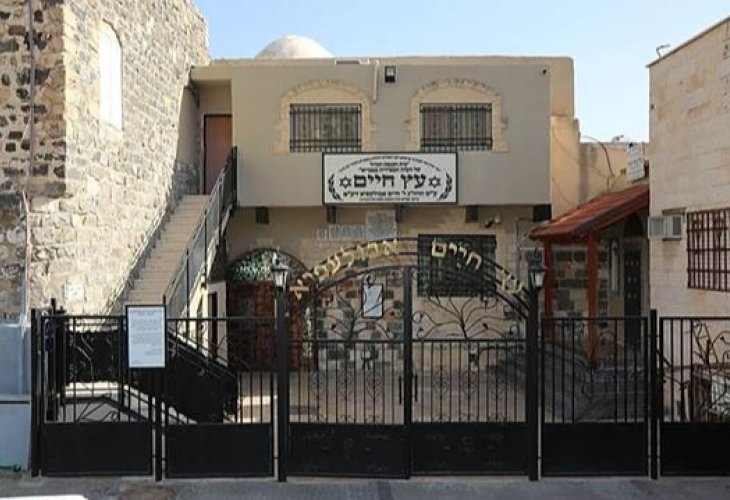 Photo: Oshri Weitzman
Photo: Oshri WeitzmanIf anything excites the Jews of Tiberias beyond Ron Kobi's temporary removal from the city and the ever-rising Kinneret, it's the revival of the previously dry mikveh. Tiberias is abuzz these days due to the mikveh filled with water, courtesy of abundant rains and the Kinneret's rising levels.
With the excitement over the Kinneret's increase, we set out to explore the history of the ancient 'Etz Chaim' synagogue that hosts this unique mikveh, rumored to have been frequented by the holy Ari. We sought to uncover its glorious past and witness the wonders of creation first-hand. Accompanying us was the gabai and cantor, Yosef Revach, a diligent man, whose name is synonymous with the synagogue's activities. Revach, who has been the voice of this sacred place since 1980, serving as the cantor, kindly joined us to share the synagogue's history with our readers.
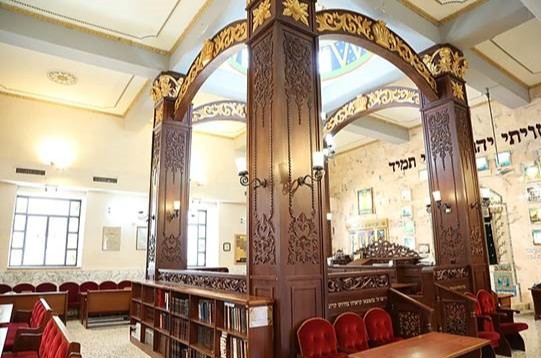 Photo: Oshri Weitzman
Photo: Oshri Weitzman
Miriam's Well Seen from the Synagogue
We arrive at the end of the pedestrian street leading to the boardwalk. To the right, behind the memorial plaque for IDF fallen soldiers, stands an ancient and impressive stone building over two floors. This is the 'Etz Chaim' synagogue, one of the few remaining structures from ancient Tiberias. Its lower part dates back to ancient times, while the upper rows of stones are newer. The synagogue, measuring 15 by 15 meters, was formerly called "The Great Synagogue of the Sephardic Community" and by others "The Ancient Synagogue, Kanishta Rabba."
The synagogue made headlines this week when its fixed mikveh's pit filled again. This highly unique mikveh is connected to the Kinneret and fills based on natural siphoning laws. It had been inactive due to the falling levels of the Kinneret in recent years. After the rainy winter of 5773 (2013), the Kinneret rose, allowing immersion in the mikveh, but subsequent droughts caused the levels to drop again, leaving the mikveh dry. This year, the water level rose, coming just 1.4 meters shy of a full Kinneret, allowing the mikveh to rise by exactly one meter, making it once again fit for immersion.
We are in awe of the place's sanctity and the precision preservation the synagogue has endured. "The 'Etz Chaim' synagogue structure, built by Rabbi Chaim Abulafia during the renewal of the Jewish settlement in Tiberias in 1740, has been preserved with great authenticity since its establishment, maintaining its restored form since 1950," Revach declares proudly at the conversation's start.
We arrive at the revelation before our eyes - the mikveh built by Rabbi Chaim Abulafia, attributed with immense sanctity. This ancient mikveh receives its water through an age-old tunnel connecting it to the Kinneret, whose path has never been revealed. When the Kinneret is low, the mikveh is dry; when it rises, the mikveh fills.
The original structure was altered about two hundred years ago, and in 1934 the synagogue moved away from the sea following a major flood that claimed dozens of residents' lives. As a lesson from the disaster, the British mandate dried a coastal strip and built the now-known boardwalk. This area is colloquially called 'the Bund' in Tiberias. Homes that were once on the water's edge moved away from the Kinneret, and since, water access to the mikveh has become more challenging, filling only in rainy years when the Kinneret rises. In the synagogue's northwest corner, beneath a magnificent old wooden gate, with ancient carvings, there is another water pit formerly used for ritual hand washing. History tells of a miraculous occurrence for Rabbi Chaim Abulafia while washing his hands - the waters rising to him. These waters served many generations, and additionally, in the north-western corner of the synagogue lies a very deep water well, believed to date back to Roman times or earlier, likely created for the purification of worshippers' hands.
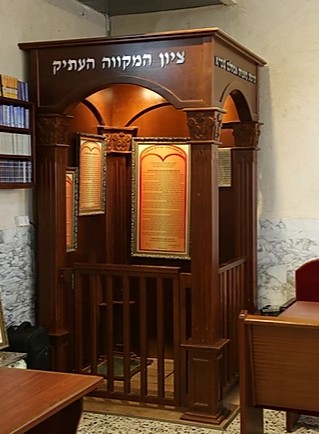 Photo: Oshri Weitzman
Photo: Oshri Weitzman"For nearly twenty years, there were no waters in the mikveh," says Revach. "Last winter the waters began to rise, and this year we are experiencing another rainy winter, and the mikveh waters continued to rise as well. It is hard to describe the joy this causes."
Revach was born in old Tiberias and recalls how synagogue worshippers used to immerse in the mikveh. "Entering to immerse today evokes childhood memories. I see before me the old city awakening to life. It's a sublime feeling."
From historical texts, we find vibrant depictions and firsthand testimonials written by R' Moshe Reischer of blessed memory in his book 'Shaarei Yerushalayim': "Tiberias too was in ruins, and the righteous Rabbi Chaim Abulafia came decades later... and he rebuilt its ruins. Also, the synagogue of the Sephardic community was built by the rabbi over the ruins where the holy Ari prayed." According to historical records, the synagogue underwent ups and downs, destroyed and rebuilt several times. In fact, the synagogue was destroyed thrice. Twice by earthquakes, in 1759 and 1837, and once by a significant flood in 1934. Since its rededication in 1950, this revered small sanctuary stands, welcoming many visitors.
"In past years," continues Revach, "there was a legend of a menorah that burned in the synagogue day and night without ceasing, and individuals kept vigil by rotation, eyes fixed on the Kinneret, looking toward where Miriam's well should be, hoping for the redeemer. According to history, 'the windows of the Etz Chaim synagogue overlooked the Kinneret, enabling the observer to see Miriam's well.' It's also said: 'A whirlpool in the water... and Jews had small boats, setting out to draw water from Miriam's well. As they approached, nothing was seen, hence someone always remained by the synagogue window to guide them, and when they reached the well, they gestured them to stop, draw, and return, and these waters were drunk in Tiberias.' Thus said Laurence Oliphant, initiator of the Jewish settlement plan in the land of Israel."
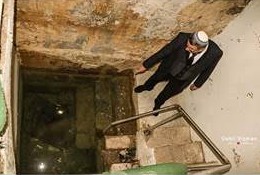 Photo: Oshri Weitzman
Photo: Oshri Weitzman
"This Place is Sacred"
"In the renewed building, two marble plaques were placed," continues Revach guiding us, "one in the southwest corner, inscribed: 'This place is sacred.' At this corner, our master the Ari of blessed memory prayed, as mentioned in the book 'Kippot HaShelah.' Indeed, no one dared to sit under this spot. The second plaque was placed on the synagogue entrance, inscribed: 'How beautiful and pleasant is the great synagogue of Tiberias, praised in the gates of daughter Zion,' with the addition: 'A pure heart greatly dedicated by the righteous R' Yitzchak Goeta of Trieste, may his light shine upon the completion of its building...' '
"About twenty years later, Rabbi Abraham Rozanes visited the site. He described the synagogue's beauty in these words: 'Great and magnificent to the utmost beauty, unlike anything I've seen throughout the land of Israel. It accommodates over five hundred worshippers, beautifully adorned with pure marble stones and artistically tiled floors, words of praise indeed.' Revach also reveals to us that in the summer of 5705 (1945), a notice titled "How Awesome is This Place, This is None Other than the House of God" was distributed, in which the Sephardic chief rabbi of then Tiberias, R' Yaakov Chai Zrihen, and the mayor, Shimon Dahan, called for donations to renovate the synagogue. As a result, 228 Tiberias families collectively donated 1,228 Palestine liras. About two years later, committee representatives signed a contract with contractor Mordechai Rahamim Saida. However, the building's construction was delayed by the War of Independence (5708), finally completed and inaugurated with much fanfare at the start of 5710 (1950). From 1950, the site also served as a "Talmud Torah," with students learning Torah in its corners, while evenings saw celebrations and weddings."
Is it true the Sanhedrin sat in the 'Etz Chaim' synagogue?
Revach affirms, surprising us with explicit references proving that indeed the last Sanhedrin sat in the synagogue's hall. "According to the words of Tiberias' greatest rabbis, particularly the holy Kabbalist R' Yaakov Shealtiel Ninyo of blessed memory and our master Chaim Nissim Abulafia of blessed memory, the chief rabbi of Tiberias and Safed, as written in the preface to the book 'Sade Yitzchak,' the Sanhedrin's place was where the 'Etz Chaim' and 'Mashmia Yeshuah' synagogue now stand. The synagogue was also called 'Bi Kanishta Rabba of Tiberias,' adding to the authenticity of the ancient source where many rabbis gathered and assembled in Tiberias. The ancient stone with the inscription 'Bi Kanishta Rabba of Tiberias' found beneath the Ark of the Covenant serves as historical evidence of the place's eminence.
"Visitors should know," Revach adds with evident excitement, "that according to tradition, the Sanhedrin sat in this city and will be reestablished here before the redemption. According to a certain Kabbalistic teaching, it is at the place called 'Etz Chaim' synagogue where the Sanhedrin will return. It is known that the holy Ari, upon arriving in Tiberias, prayed here. In the book 'Tabor HaAretz,' it is written: 'In Tiberias itself, within the city, facing the sea's end is a large synagogue for Jews, possessing great ancient holiness. It is not in the south wall where the Ark now is, but in the middle along the synagogue's length, in the second arch in the corner from the west, where the Ari permanently established his place of prayer.' Behold, this is the place where an inscribed stone marker stands, bearing 'This Place is Sacred,'" Revach points to the ancient stone.
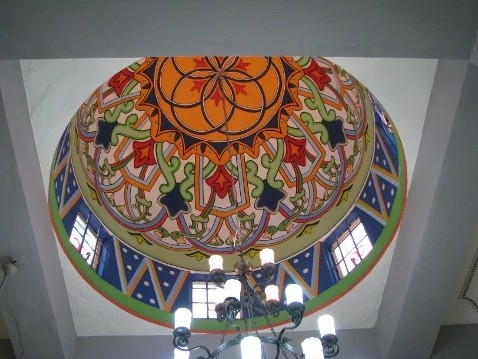 Impressive Glass Art on the Synagogue Ceiling. Photo: Oshri Weitzman
Impressive Glass Art on the Synagogue Ceiling. Photo: Oshri WeitzmanHow active is the synagogue daily?
"The synagogue remains vibrant and bustling year-round," Revach replies, "Throughout the year, it serves the local community, primarily hotel visitors surrounding it. On Iyar 14 annually, we organize a large procession from the synagogue to the tomb of Rabbi Meir Baal HaNes in the city's south, following the ancient tradition celebrated by Tiberias' residents since 1743, remembrance days and holidays, especially pilgrimages to the graves of Israel's great righteous buried in Tiberias' holy ground." Revach quotes from Laurence Oliphant's memories, who participated in such a pilgrimage in 1879, writing: "By afternoon, the celebrants gathered by the great synagogue on the shore of the Sea of Galilee, namely the 'Etz Chaim' synagogue, setting out from there with Torah scrolls in procession headed by community rabbis, through old city's alleys towards Rabbi Meir Baal HaNes tomb. Along the seaside, the road was full of Jewish groups, men, women, and children, all in finery, heading to the celebration site. The two sailboats the Sea of Galilee could boast were commandeered for the ceremony, sailing leisurely with their big sails spread in the gentle breeze, filled to the brim with women and children."
*
An ancient aura and continuous sanctity accompany us upon leaving the synagogue, after realizing that some opinions hold that the Sanhedrin sat here with their crowns and judged Israel. The ancient mikveh also adds to the place's mysterious aroma and anticipation for our Messiah’s arrival, restoring our days as of old.

